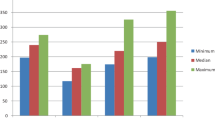Abstract
PURPOSE: Intraperitoneal adhesions may help the healing of marginally viable bowel ends. If adhesion formation is prevented by various methods, the integrity of ischemic bowel anastomosis may be compromised. Thus, we decided to study the effects of hyaluronic acid–carboxymethylcellulose, an antiadhesion barrier, on ischemic bowel anastomosis. METHODS: Thirty Wistar-Albino rats were divided into three groups. In Group A (control), a well-perfused distal colonic segment was transected, and free ends were anastomosed. In Group B, an ischemic colonic segment was prepared, then divided and anastomosed. In Group C, after completion of ischemic colonic anastomosis, hyaluronic acid–carboxymethylcellulose film was wrapped around the anastomosis. In all groups, rats were killed on the seventh day. Intraperitoneal adhesions were graded by adhesion score, and healing of the anastomosis was assessed by measurement of bursting pressure and hydroxyproline levels in the anastomotic tissue. RESULTS: A statistically significant difference was found between hydroxyproline levels of the control group and the ischemic group (P = 0.02). HP level was also significantly higher in the hyaluronic acid–carboxymethylcellulose group than in the ischemic group (P = 0.01). There was no difference in hydroxyproline levels between the control and hyaluronic acid–carboxymethylcellulose groups. Compared with the control group, bursting pressure was lower in the ischemic group (P = 0.02). Hyaluronic acid–carboxymethylcellulose wrapping increased the bursting pressure significantly (P < 0.001). However, there was no difference in bursting pressure between the control group and the hyaluronic acid–carboxymethylcellulose group (P = 0.13). A marked increase in the adhesion score was observed in the ischemic group (P = 0.01). The difference between adhesion scores of the hyaluronic acid–carboxymethylcellulose and ischemic groups was not found to be significant, although the adhesion score in the hyaluronic acid–carboxymethylcellulose group was lower (P = 0.16). There was no difference in adhesion score between the control and hyaluronic acid–carboxymethylcellulose groups. CONCLUSIONS: Application of hyaluronic acid–carboxymethylcellulose in ischemic colonic anastomosis did not compromise anastomotic integrity. The adverse effect of ischemia on healing of colonic anastomosis was counteracted by hyaluronic acid–carboxymethylcellulose.
Similar content being viewed by others
References
AH DeCherney GS diZegera (1997) ArticleTitleClinical problem of intraperitoneal postsurgical adhesion formation following general surgery and the use of adhesion prevention barriers Surg Clin North Am 77 671–688
JM Becker MT Dayton VW Fazio et al. (1996) ArticleTitlePrevention of postoperative abdominal adhesions by a sodium hyaluronate-based bioresorbable membrane J Am Coll Surg 183 297–306
M Medina HN Paddock RJ Connoly SD Schwaitzberg (1995) ArticleTitleNovel adhesion barrier does not prevent anastomotic healing in rabbit model J Invest Surg 8 179–186
D Bowers RB Raybon CR Wheeless SuffixJr (1999) ArticleTitleHyaluronic acid-carboxymethylcellulose film and perianastomotic adhesions in previously irradiated rats Am J Obstet Gynecol 181 1335–1338
MP Diamond A Hershlag (1989) ArticleTitleAdhesion formation/reformation Prog Clin Biol Res 358 23–33
BJ Monk ML Berman FJ Montz (1994) ArticleTitleAdhesions after extensive gynecologic surgery Am J Obstet Gynecol 170 1396–1403
H Ellis (1980) ArticleTitleInternal overhealing World J Surg 4 303–306
A Uzunkoy OF Akinci A Coskun O Aslan A Kocyigit (2000) ArticleTitleEffects of antiadhesive agents on the healing of intestinal anastomosis Dis Colon Rectum 43 370–375
TS Griffen PF Hagihara (1982) ArticleTitleIschemic colitis in rats Dis Colon Rectum 25 638–640
DJ Prochop KI Kivirikko (1967) ArticleTitleRelationship of hydroxyproline excretion in urine to collagen metabolism Ann Intern Med 66 1243–1266
SK Nair IK Bhat AL Aurora (1974) ArticleTitleRole of proteolytic enzyme in the prevention of postoperative intraperitoneal adhesions Arch Surg 108 849–852
D Menzies H Ellis (1990) ArticleTitleIntestinal obstruction from adhesions—how big is the problem? Ann R Coll Surg Engl 72 60–63
DJ Costain R Kennedy C Ciona VC McAlister TD Lee (1997) ArticleTitlePrevention of postsurgical adhesions with N, O-carboxymethyl chitosan Surgery 121 314–319
RJ Felton DW Tuggle AL Milewicz et al. (1990) ArticleTitleHigh mortality with an intraperitoneal antiadhesive in the rat Curr Surg 47 444–446
MA Damario JA Rock (1995) ArticleTitleMethods to prevent postoperative adhesion formation in gynecologic surgery J Gynecol Technol 1 77–88
AF Haney E Doty (1992) ArticleTitleMurine peritoneal injury and de novo adhesion formation caused by oxidized-regenerated cellulose (Interceed TC7) but not expanded polytetrafluoro-ethylene (Gore-Tex surgical membrane) Fertil Steril 57 202–208
M Thornton GS diZegera (1996) ArticleTitleUsing barriers to prevent adhesions Contemp Obstet Gynecol 41 107–124
TE Elkins FW Ling RA Ahokas TN Abdella CA Homsey LR Malinak (1984) ArticleTitleAdhesion prevention by solutions of sodium carboxymethylcellulose in the rat. II Fertil Steril 41 929–932
O Hamedah S Chilukuri V Bonet S Hussein IH Chaudry (1993) ArticleTitlePrevention of peritoneal adhesions by administration of sodium carboxymethyl cellulose and oral vitamin E Surgery 114 907–910
BJ Talbert DW Tuggle AA Askew TA Perkins DV Taylor WP Tunell (1998) ArticleTitlePreventing adhesions in the immature rat Surg Forum 39 592–594
CC Buckenmaier SuffixIII MA Summers SP Hetz (2000) ArticleTitleEffect of the antiadhesive treatments, carboxymethylcellulose combined with recombinant tissue plasminogen activator and Seprafilm, on bowel anastomosis in the rat Am Surg 66 1041–1045
FJ Van Oosterom JJ van Lanschot J Oosting H Obertop (2000) ArticleTitleHyaluronic acid/carboxymethylcellulose membrane surrounding an intraperitoneal or subcutaneous jejunojejunostomy in rats Eur J Surg 166 654–658
Author information
Authors and Affiliations
About this article
Cite this article
Erturk, S., Yuceyar, S., Temiz, M. et al. Effects of Hyaluronic Acid–Carboxymethylcellulose Antiadhesion Barrier on Ischemic Colonic Anastomosis. Dis Colon Rectum 46, 529–534 (2003). https://doi.org/10.1007/s10350-004-6594-1
Issue Date:
DOI: https://doi.org/10.1007/s10350-004-6594-1




